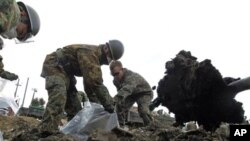As Japan faces the monumental task of cleaning up after the devastating March 11 earthquake and tsunami, the role that troops and, particularly U.S. forces, are playing is in the forefront.
Three weeks after the devastating tsunami that destroyed thousands of homes in the small community of Ishinomaki, the Minato elementary school is still a mess.
A thick layer of mud covers the yard, smashed and crushed cars lie all around, and a mountain of debris from inside the school is waiting to be removed.
This day, that job falls upon the U.S. Marine Corps.
Captain Adan Maldonado is one of a small group of U.S. soldiers working to help the school take a further step towards recovery.
"We're in the third day of 'Operation Field Day', in which the Marines and soldiers of Task Force Fuji are coming out with heavy equipment to clean up the school yard at Minato elementary school," he says. "Yesterday, we came out with about 312 backpacks for ages of infant all the way up to 18 years of age and we had trinkets and clothing and candies, and those came from the girl scouts at Camp Zama."
The U.S. government pledged full support to Japan on the day of the disaster. Much of the subsequent work has fallen on the U.S. military, which has 38,000 personnel permanently stationed in Japan.
Video of US military efforts in Japan
Under the banner of "Operation Tomodachi," the Japanese word for friend, the U.S. military has brought in more than 260 tons of relief supplies, flown 160 aerial sorties, and searched over 5,000 square kilometers of ocean looking for survivors.
It has also cleared the tsunami-hit Sendai airport so relief supplies can be flown directly into the disaster region.
The U.S. military is working alongside the Japanese Self Defense Forces, as Captain Maldonado explains.
"Essentially, we're in a supporting role of the JGSDF, so anything they ask for help, we're right there with them to support as soon as possible. The people have been very receptive, lots of 'hi's, hellos, thank yous'," Maldonado says.
On Monday, the United States military got the biggest thank you yet, from Japanese Defense Minister Toshimi Kitazawa.
Minister Kitazawa said the Japanese government and people express their deep appreciation for the work of the United States military and Operation Tomodachi. He added he has never been more encouraged and proud that the United States is Japan's ally.
Japan's Self Defense Forces, under Kitazawa, have a presence of some 100,000 in the region. Ground Self Defense Force Colonel Shohei Abe says they are working on a variety of missions.
"Search and recovery of the dead bodies, life support like transporting food and water, and also debris removal in the public facility," says the colonel.
It is not all grim work. The military is also working to make the lives of evacuees just a little bit more bearable.
Across the river from the Ishinomaki elementary school, steam rises into the cold air from several large, green tents. These are shower units, installed by Japanese troops to help the city that is still largely without gas.
And from the mud and rubble of the Ishinomaki elementary school, an impromptu concert by the 5th band of the Ground Self Defense Forces brought work to a standstill at lunchtime Saturday.
Perhaps, just for a minute, it helped people to forget the disaster that has taken over their lives.










